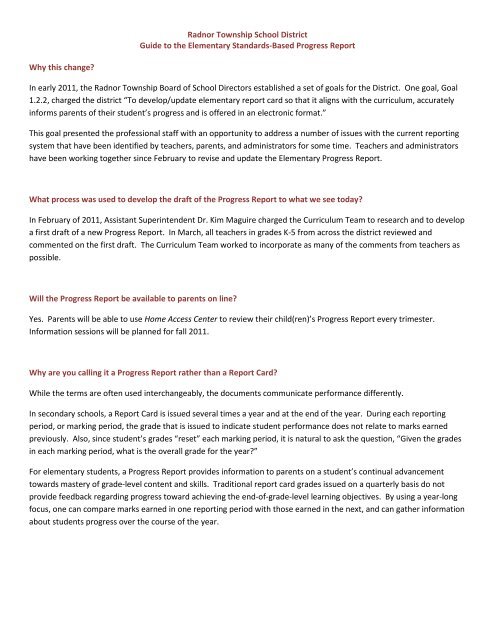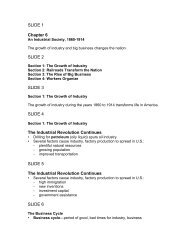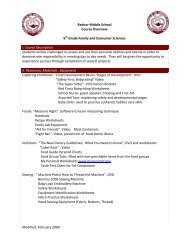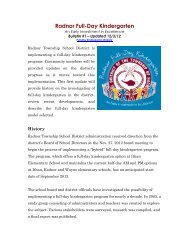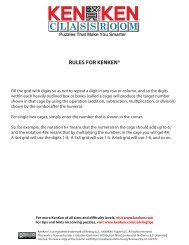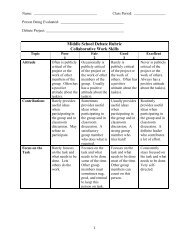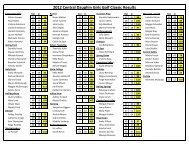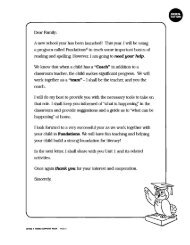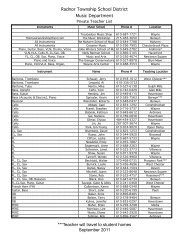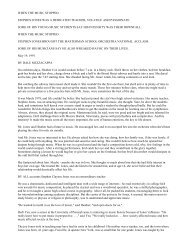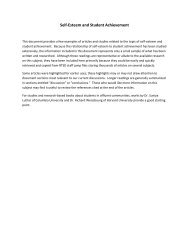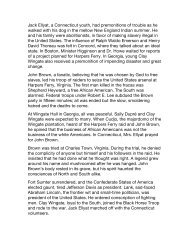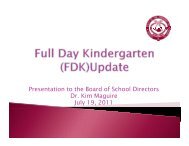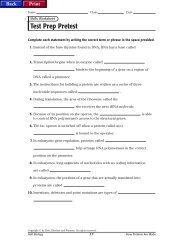Parent Guide to Elementary Standards Based Progress Report
Parent Guide to Elementary Standards Based Progress Report
Parent Guide to Elementary Standards Based Progress Report
You also want an ePaper? Increase the reach of your titles
YUMPU automatically turns print PDFs into web optimized ePapers that Google loves.
Radnor Township School District<br />
<strong>Guide</strong> <strong>to</strong> the <strong>Elementary</strong> <strong>Standards</strong>-<strong>Based</strong> <strong>Progress</strong> <strong>Report</strong><br />
Why this change?<br />
In early 2011, the Radnor Township Board of School Direc<strong>to</strong>rs established a set of goals for the District. One goal, Goal<br />
1.2.2, charged the district “To develop/update elementary report card so that it aligns with the curriculum, accurately<br />
informs parents of their student’s progress and is offered in an electronic format.”<br />
This goal presented the professional staff with an opportunity <strong>to</strong> address a number of issues with the current reporting<br />
system that have been identified by teachers, parents, and administra<strong>to</strong>rs for some time. Teachers and administra<strong>to</strong>rs<br />
have been working <strong>to</strong>gether since February <strong>to</strong> revise and update the <strong>Elementary</strong> <strong>Progress</strong> <strong>Report</strong>.<br />
What process was used <strong>to</strong> develop the draft of the <strong>Progress</strong> <strong>Report</strong> <strong>to</strong> what we see <strong>to</strong>day?<br />
In February of 2011, Assistant Superintendent Dr. Kim Maguire charged the Curriculum Team <strong>to</strong> research and <strong>to</strong> develop<br />
a first draft of a new <strong>Progress</strong> <strong>Report</strong>. In March, all teachers in grades K-5 from across the district reviewed and<br />
commented on the first draft. The Curriculum Team worked <strong>to</strong> incorporate as many of the comments from teachers as<br />
possible.<br />
Will the <strong>Progress</strong> <strong>Report</strong> be available <strong>to</strong> parents on line?<br />
Yes. <strong>Parent</strong>s will be able <strong>to</strong> use Home Access Center <strong>to</strong> review their child(ren)’s <strong>Progress</strong> <strong>Report</strong> every trimester.<br />
Information sessions will be planned for fall 2011.<br />
Why are you calling it a <strong>Progress</strong> <strong>Report</strong> rather than a <strong>Report</strong> Card?<br />
While the terms are often used interchangeably, the documents communicate performance differently.<br />
In secondary schools, a <strong>Report</strong> Card is issued several times a year and at the end of the year. During each reporting<br />
period, or marking period, the grade that is issued <strong>to</strong> indicate student performance does not relate <strong>to</strong> marks earned<br />
previously. Also, since student’s grades “reset” each marking period, it is natural <strong>to</strong> ask the question, “Given the grades<br />
in each marking period, what is the overall grade for the year?”<br />
For elementary students, a <strong>Progress</strong> <strong>Report</strong> provides information <strong>to</strong> parents on a student’s continual advancement<br />
<strong>to</strong>wards mastery of grade-level content and skills. Traditional report card grades issued on a quarterly basis do not<br />
provide feedback regarding progress <strong>to</strong>ward achieving the end-of-grade-level learning objectives. By using a year-long<br />
focus, one can compare marks earned in one reporting period with those earned in the next, and can gather information<br />
about students progress over the course of the year.
Why is it standards based? What is standards-based grading and reporting?<br />
<strong>Standards</strong>-based education is not new <strong>to</strong> education or <strong>to</strong> Radnor; standards have been an important part of Radnor’s<br />
curriculum for a number of years. Additionally, standards documents exist at the state and national level for all<br />
disciplines.<br />
Since standards are supported by classroom instruction using standards-based texts and standards-based lessons,<br />
standards-based progress reports inform parents specifically about what students know and are able <strong>to</strong> do and align<br />
more closely <strong>to</strong> our curriculum materials, instructional practices, and assessment systems.<br />
How were these standards documents selected?<br />
The <strong>Progress</strong> <strong>Report</strong> reflects language from the following standards documents:<br />
Subject<br />
English Language Arts<br />
Mathematics<br />
Science<br />
Social Studies<br />
Art<br />
Music<br />
Physical Education & Health<br />
Library<br />
<strong>Standards</strong> Document<br />
Common Core State <strong>Standards</strong> (CCSS)<br />
(www.corestandards.org)<br />
Common Core State <strong>Standards</strong><br />
Section not revised extensively (see below)<br />
Section not revised extensively (see below)<br />
National <strong>Standards</strong> for Arts Education<br />
National <strong>Standards</strong> for Music Education<br />
National Association of Sport and Physical Education and<br />
National Health Education <strong>Standards</strong><br />
American Association of School Librarians<br />
The Pennsylvania State Board of Education adopted the Common Core State <strong>Standards</strong> (CCSS) July 2, 2010. States<br />
adopting the CCSS must adopt the document verbatim and in its entirety but are permitted <strong>to</strong> add statements <strong>to</strong><br />
incorporate any PA standards not addressed in CCSS. Alignment studies and transition planning continues with full<br />
implementation of the CCSS for the 2013-2014 school year. By aligning language on our new report card <strong>to</strong> CCSS now,<br />
RTSD will save time later. CCSS standards are not yet available for Science and Social Studies. RTSD will examine these<br />
sections of the elementary progress report depending on the outcome and development of CCSS standards in these<br />
disciplines.<br />
Additional information about the CCSS initiative can be found at www.pdesas.org/Standard/CommonCore .<br />
How will marks determined?<br />
In standard based classrooms, the focus is on the student’s performance over multiple opportunities, rather than the<br />
simple grading and averaging of tests and quizzed. Student knowledge and skills are measured on a continual basis;<br />
teacher collect evidence from a variety of sources including careful observations, examination of class work, discussions,<br />
projects, quizzes, and tests. Teachers record information about each child’s progress, compile that information and use<br />
the data <strong>to</strong> evaluate student performance.<br />
How were the Rating Scales developed?
The Rating Scales that are proposed include two different scales: an Academic Performance Level and a Qualitative<br />
Performance Level. Depending on the item that is being reported, an Academic mark or Qualitative mark would be<br />
given. On the draft of the <strong>Progress</strong> <strong>Report</strong> available at www.rtsd.org/<strong>Elementary</strong><strong>Progress</strong><strong>Report</strong>, you will see<br />
indications of whether an Academic (A) or Qualitative (Q) mark would be issued for each item.<br />
Work on the Rating Scales continues and we are asking for suggestions about how <strong>to</strong> improve this section. If you<br />
have a question or comment on this section, please participate in our survey, located at<br />
http://www.surveymonkey.com/s/RTSD<strong>Elementary</strong><strong>Progress</strong><strong>Report</strong>.<br />
If you’re measuring progress <strong>to</strong>ward a grade-level standard, can a mark ever “go down”?<br />
Yes. Student skills are expected <strong>to</strong> develop in sophistication over the course of the year, and it would be unfair <strong>to</strong><br />
students <strong>to</strong> assess them on skills they have not yet learned. Thus, concepts grow in complexity and the assessment<br />
tasks students are asked <strong>to</strong> perform also increase in complexity.<br />
Consider 2 nd grade mathematics. At the beginning of the year, students might be assessed on their ability <strong>to</strong> count by<br />
10’s <strong>to</strong> 100, but by the end of the year assessed on their ability <strong>to</strong> count <strong>to</strong> 1000. At the first conference time, there<br />
might be indication that the child is “Proficient” thus far in Operations and Computation, but as the skill demands<br />
increase, there would need <strong>to</strong> be an increase in the child’s abilities <strong>to</strong> maintain that “Proficient” mark.<br />
What if a child never reaches proficiency in all areas?<br />
Our curriculum, instruction, and assessments are designed for students <strong>to</strong> show proficiency. It is our expectation that all<br />
students be proficient. For those who struggle <strong>to</strong> meet those targets, the <strong>Standards</strong>-<strong>Based</strong> <strong>Progress</strong> <strong>Report</strong> helps<br />
identify specific areas where students need support.<br />
What if a child shows proficiency in end-of-grade-level expectations in all areas?<br />
Teachers work with all students <strong>to</strong> continue <strong>to</strong> develop them <strong>to</strong> their highest level of potential. When a student is<br />
proficient in all of the skills identified at the grade level, teachers differentiate instruction <strong>to</strong> move students beyond the<br />
identified goals <strong>to</strong> deeper levels of understanding.
How were the Qualities of a Learner developed?<br />
The work habits that students bring <strong>to</strong> the learning environment are critical <strong>to</strong> a student’s long-term success. The<br />
Qualities of a Learner section draws on language that exists on our current report cards, but modifying that language so<br />
that is usable from grade K <strong>to</strong> 5. Additionally, this section is expanded using language drawn from report cards in other<br />
local schools. Teachers have reviewed this section in great detail and it has been modified extensively since its first<br />
draft.<br />
Work on the Qualities of a Learner section continues and we are asking for suggestions about how <strong>to</strong> improve this<br />
section. If you have a question or comment on this section, please participate in our survey, located at<br />
http://www.surveymonkey.com/s/RTSD<strong>Elementary</strong><strong>Progress</strong><strong>Report</strong>.<br />
How were the Core Subject sections developed?<br />
In the case of Language Arts and Mathematics, descrip<strong>to</strong>rs were drawn and synthesized from the Common Core State<br />
<strong>Standards</strong> (CCSS) documents (see above). Language in the sections of Science and Social Studies has been reviewed by<br />
teachers and will be addressed in the future should CCSS become available in those areas.<br />
Additional documents will be created that specify the grade-level knowledge and skills that students are expected <strong>to</strong><br />
master. Examples will be similar <strong>to</strong> the language in the CCSS (see www.pdesas.org/Standard/CommonCore).<br />
Why is there a single mark for a skill-set like Operations and Computation rather than three different marks for each<br />
of the skills in that set?<br />
In order <strong>to</strong> give an accurate mark in any given category, it must be assessed multiple times and in multiple ways. Larger<br />
categories allow for sufficient validity with fewer assessment events. Using the specific example cited in the question,<br />
our current assessment system in math is based on the end-of-unit assessments. Using the end-of-unit assessments, a<br />
teacher might not have formally assessed Making Reasonable Estimates enough times in a given reporting period <strong>to</strong><br />
provide an accurate mark for that specific skill, but will have assessed the skill-set of Operations and Computation a<br />
sufficient number of times so that a broader mark is valid.<br />
How were the Special Subject sections developed?<br />
In March 2011, K-5 special subject teachers from across the district in Music, Art, Health and Physical Education, and<br />
Library worked <strong>to</strong> develop their own sections of the report card. In each case, they based the language on the report<br />
card on the nationally recognized standards document of their professional association. Library will appear on the<br />
<strong>Progress</strong> <strong>Report</strong> beginning in the 2012-2013 school year.<br />
Two marks appear in the Special subjects that do not appear in the Core subjects—Behavior and Comments. Since<br />
special area teachers are typically unable <strong>to</strong> attend each parent-teacher conference, they wanted a way <strong>to</strong> communicate<br />
students’ behaviors in their classes <strong>to</strong> you in a manner similar <strong>to</strong> how your child’s classroom teacher will use the<br />
Qualities of a Learner section. Additionally, Special subject teachers will have a list of comments <strong>to</strong> choose from <strong>to</strong><br />
provide parents with additional feedback about how their children are performing in class.
What if my child is in 4 th grade? Will the Health section appear? What if my child isn’t in Instrumental Music? Will<br />
those sections be blank?<br />
As we have been redesigning the elementary report card, we have been examining how we can use the technologies<br />
currently present in the district. Using that technology, we will be able <strong>to</strong> have the appropriate sections of the report<br />
card appear (or not appear) as appropriate. Thus, students who are in Strings will have the Strings section au<strong>to</strong>matically<br />
appear on their report card. Students not in Strings will not have this blank space. Likewise, the section for Wellness<br />
will be reported and appear on the report cards of students in grades 1-4, but will be replaced by a section for Health<br />
when the student is in grade 5. There are other examples on the report card (recorder skills, some reading foundational<br />
skills, and others) that will appear and disappear depending on the grade level of the child.<br />
What improvements does this <strong>Progress</strong> <strong>Report</strong> offer over our current system?<br />
This new <strong>Progress</strong> <strong>Report</strong> is better than our existing reporting system for the following reasons:<br />
1) It helps <strong>to</strong> guide the discussions between parents and teachers about the knowledge and skills students should<br />
master for the grade.<br />
2) It improves communication between schools, parents, and students.<br />
3) It helps students understand the expectations at each grade level.<br />
4) It can help parents support learning at home.<br />
5) It increases communication between and among teachers.<br />
6) It uses consistent language all elementary grades and across all buildings.<br />
7) It is grounded in nationally recognized professional standards documents.<br />
8) It identifies learning patterns over the course of a child’s elementary career.<br />
9) It is supported by current educational research.<br />
What happened <strong>to</strong> the grades in 5 th grade? Won’t the absence of grades on the 5 th grade report card be detrimental<br />
<strong>to</strong> my child at the Middle School?<br />
In a standards-based learning environment, the emphasis is on learning and continual progress. A letter or percentage<br />
grade tells a student how he or she performed on average in a broad area but typically does not provide the sort of<br />
feedback that fosters mastery learning. Rather, objective, standardized measures of performance are used.<br />
When will this be in place?<br />
This new <strong>Progress</strong> <strong>Report</strong> will be in use November of 2011.
How frequently will <strong>Progress</strong> <strong>Report</strong>s be distributed?<br />
<strong>Progress</strong> <strong>Report</strong>s will be issued on the same schedule as they currently are: once each in November and March,<br />
accompanied by a conference, and once at the conclusion of the school year.<br />
What will the <strong>Progress</strong> <strong>Report</strong> look like?<br />
The final look of the <strong>Progress</strong> <strong>Report</strong> is still being developed at this time. Currently, our work is focusing on the content<br />
of the <strong>Progress</strong> <strong>Report</strong> and how effectively it communicates with parents rather than the aesthetics.<br />
How can parents provide feedback on the <strong>Progress</strong> <strong>Report</strong>?<br />
A survey is available <strong>to</strong> parents by visiting http://www.surveymonkey.com/s/RTSD<strong>Elementary</strong><strong>Progress</strong><strong>Report</strong>. We invite<br />
your feedback.<br />
Will this be the final time parents can provide feedback?<br />
No. Beginning with the first use of the <strong>Progress</strong> <strong>Report</strong> in November of 2011 and continuing until June of 2012, parents<br />
and teachers will have the opportunity <strong>to</strong> provide feedback about the report card and offer suggestions for its<br />
improvement.<br />
Additional Reading<br />
Association for Supervision and Curriculum Development. (2002). Grading and reporting student learning: An ASCD<br />
professional inquiry kit. Alexandria, VA: Author.<br />
Colby, S. A. (1999). Grading in a <strong>Standards</strong>-<strong>Based</strong> System. Educational Leadership, 57(6), p. 52-55.<br />
Guskey, T. R., & Bailey, J. M. (2001). Developing Grading and <strong>Report</strong>ing Systems for Student Learning. Thousand Oaks,<br />
CA: Corwin Press.<br />
Marzano, R. (2000). Transforming Classroom Grading. Alexandria, VA: Association for Supervision and Curriculum<br />
Development.<br />
Wiggins, G. (1996). Honesty and fairness: Toward better grading and reporting in communicating student learning: 1996<br />
Yearbook of the Association for Supervision and Curriculum Development T. R. Guskey, (Ed.). Alexandria, VA:<br />
Association for Supervision and Curriculum Development.


